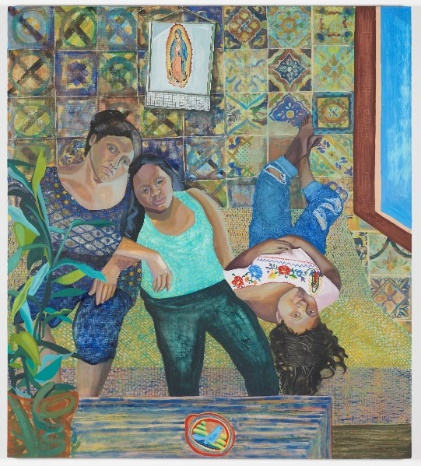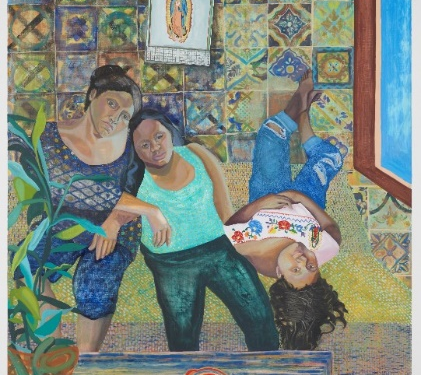How long have you realized that motherhood is priceless? Remember all the energy, attention, and time that parents have devoted to their child. Is it possible to measure motherhood? It might be impossible, but 33 diverse artists try to picture various kinds of motherhood that reflect the changing times and meanings of motherhood.
The exhibition entitled Picturing Motherhood Now focuses on art created in the past two decades, including work by Wendy Red Star and LaToya Ruby Frazier, while also integrating with significant pioneers, including Louise Bourgeois, Alice Neel, Betye Saar, and others, to narrate an intergenerational and evolving story of motherhood.

Not My Burden, 2019. Titus Kaphar (American, b. 1976). Oil on canvas; 167.6 x 153 cm. © Titus Kaphar. Image courtesy of the artist and Gagosian. Collection of Ellen Susman, Houston, Texas. Photo: Rob McKeever.
Not My Burden (2019) by Titus Kaphar is one of the artworks displayed in the exhibition. It depicts two young women sitting and holding children who disappeared. The children pictures have cut out of the canvas represents the anxiety encountered by Black mothers. Kaphar painted this work when TIME commissioned him to create a cover after George Floyd’s killing.

Las Talaveritas, 2015. Aliza Nisenbaum (American, b. 1977). Oil on linen; 162.6 x 144.8 cm. Valeria and Gregorio Napoleone Collection. © Aliza Nisenbaum. Photo courtesy the artist and Anton Kern Gallery, New York.
Aliza Nisenbaum’s Las Talaveritas (2015) is also included in the exhibition. A mother and her teenage daughter lounge in on a couch. This painting suggests the patience of a mother and the colorful life of teenage girls. This mother-daughter moment is juxtaposed with the Mother Mary picture and the vibrant pattern of the Talavera tiles on the wall behind them. Aliza Nisenbaum is well-known for her large-scale paintings of marginalized subjects and community groups.
Picturing Motherhood Now holds four thematic sections that represent different dimensions of motherhood. Firstly, ‘missing pictures’ focuses on aspects of motherhood that have been absent from traditional images of the subjects. This section explored motherhood in multiple identities and everyday life including Black and Brown motherhood. Secondly ‘making and matrilineage’ theme celebrates mothers as the leaders and maintainers of cultural traditions. Artworks under this theme express matrilineal and indigenous artistic traditions across a different generation of women.
Thirdly, the ‘Mother Tongue’ theme underscores language and narrative as the primary mediums to animate a strong female protagonist. Artists featured in this theme portray an individual experience that reflects collective social histories related to ecology, land use, and issues of economic equality. Lastly, ‘Kinships’ explore unconventional ideas of motherhood and family. Motherhood is not necessarily biological, nor even depend on normative gender identities.
Motherhood has been a core issue since the emergence of feminism. Gerda Neyer & Laura Bernardi found that feminists across generations refused the common assumption of motherhood as a given nature of women — something innate to women. The conflation of biological and social motherhood maintains women’s subordination. Feminists insisted to distinguish between biological and social motherhood to reveal the common perceptions that motherhood is a social construction that frequently allow the exploitation of women as childbearing.
Picturing Motherhood Now is featuring remarkable artworks that examine a wide spectrum of motherhood issues from “the changing definitions of family and gender, the histories and afterlives of slavery, the legacies of migration to the preservation of matrilineal indigenous cultures”.
Picturing Motherhood Now is on view at the Cleveland Museum of Art’s Kelvin and Eleanor Smith Foundation Exhibition Gallery through March 13, 2022.
Picturing Motherhood Now – Spoken Word: Alexander James


